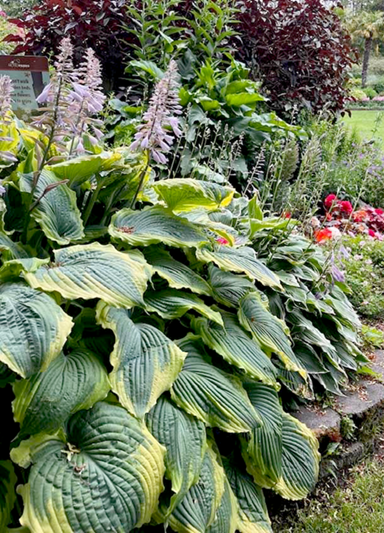Shade-loving hostas add color and texture

By Margie Rose
Hostas! They are champions of variety among plants we can grow in shade. Cool blues, greens, and variegations of white, chartreuse, and yellow paint many hostas, giving us seemingly endless choices. Breeders are busy offering many new plants of various sizes from miniature leaves to giant dinner plates. Leaves can be quilted or smooth, shiny or matte.
The more textured and thicker they are the more they’re resistant to slugs and snail damage, the only things I have seen damage them. Deer will eat them, but I fortunately don’t have that issue.
They need shade for the most part as very few will do well in sunny spots. Good drainage is a must and rich soil with compost provide ideal conditions. You can plant them in containers, even hanging ones for the small varieties.
About three decades ago I purchased a varied collection of hostas and planted them between Camellia japonicas and they still are doing well. I don’t think I have written about them before. They are so easy, requiring little attention. Every spring when their beautiful leaves emerge, I am glad that they are still residing in my garden. They are among the easiest and most reliable plants I have grown.
Although they are grown for their foliage, flowers do emerge in midsummer. The slender scapes arising from the center of the foliage are graced with trumpet shaped fragrant flowers of white or pale lavender that are magnets for hummingbirds. Since I am a big fan of hummers I am happy to see them.
I haven’t had a problem with disease or insects bothering them, but slugs and snails love the leaves. Last spring and summer were relatively dry and I had no damage but all the rain we had this spring helped slugs to thrive. I use Sluggo, an iron phosphate product that is harmless and unattractive to birds, cats, and dogs but very effective as a deterrent to slugs and snails. I have read that toads also eat them but I haven’t seen any in the garden. Because I garden without chemicals, I suspect they are living among my plants, at least I hope they are since they are valuable allies. Little garter snakes do peek out from under my plants occasionally and they are harmless, welcome residents. Little else is a problem for me and the hostas.
Ferns and other shade loving plants offer lovely contrast and enjoy the same growing conditions. For texture, cool color, endless sizes, variety, and ease of care I think hostas are hard to beat!
Questions? Leave a message at 503-645-2994 or email me at margierose2@gmail.com





